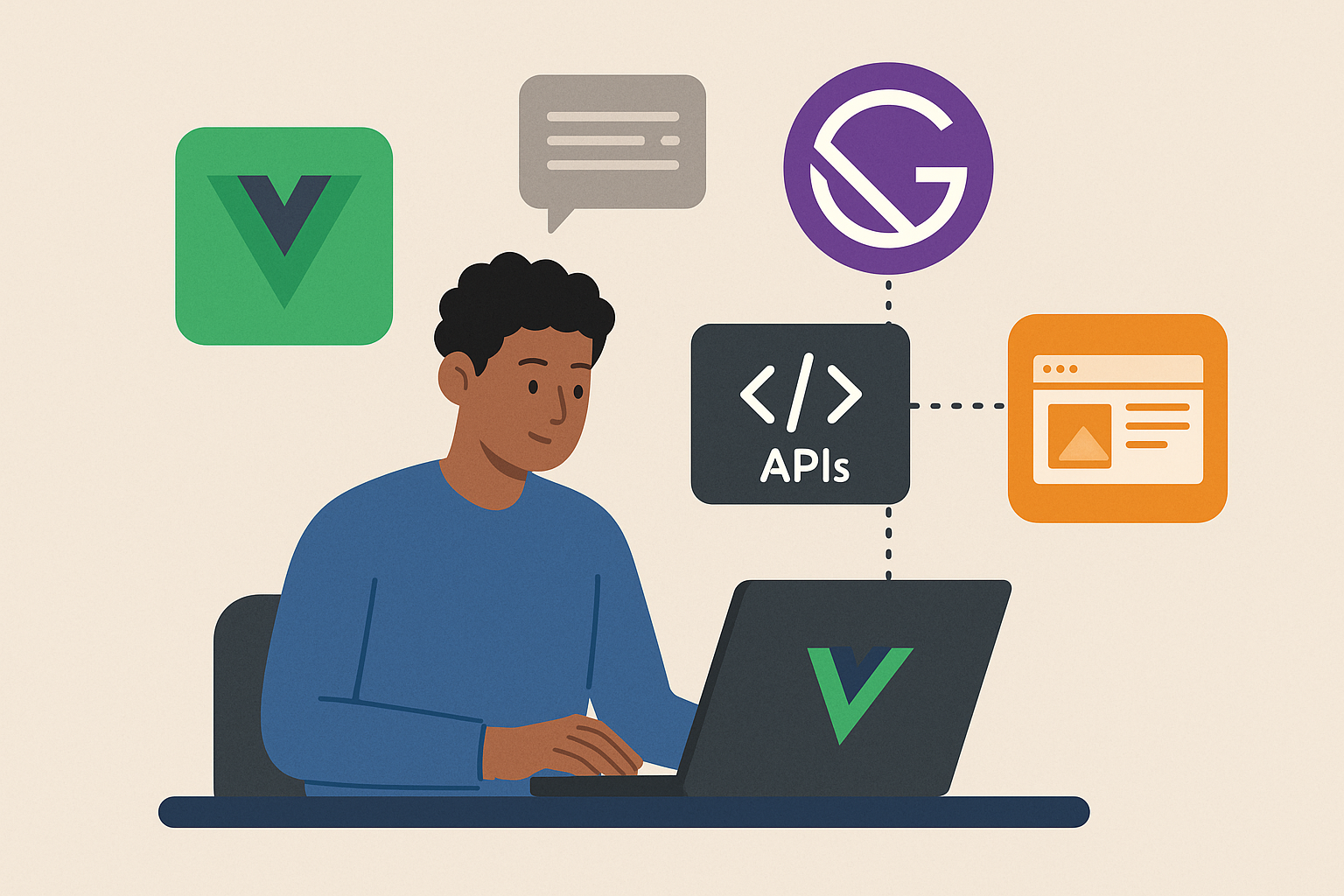Introduction
How Vue.js Fits into the JAMstack Movement. In recent years, the world of web development has undergone a quiet revolution. As developers seek faster, more secure, and scalable ways to build websites and web applications, JAMstack has emerged as a powerful modern architecture. Standing for JavaScript, APIs, and Markup, JAMstack shifts focus away from traditional monolithic systems toward decoupled, performance-optimized setups.
One JavaScript framework that has seamlessly adapted to this new wave is Vue.js. Known for its simplicity, flexibility, and strong community support, Vue.js has become a favorite choice for developers building JAMstack websites. But what exactly makes Vue.js such a good fit for JAMstack?
In this blog, we’ll explore how Vue.js complements the JAMstack philosophy, the benefits of using Vue in this environment, and some practical insights into integrating the two.
Table of Contents
Understanding JAMstack: A Quick Overview
Before diving into Vue.js, it’s important to understand the core principles of JAMstack:
- JavaScript: Handles dynamic functionalities, often via frontend frameworks like Vue, React, or Angular.
- APIs: Serve as backends for data and services, usually accessed over HTTPS.
- Markup: Refers to pre-rendered static HTML files, often generated by tools like Nuxt, Gatsby, or Hugo.
Unlike traditional server-based websites, JAMstack sites are pre-built during deployment and served via CDNs, enabling faster load times and better scalability. It’s a shift from a server-heavy approach to one that’s frontend-first, decoupled, and modular.
Why Vue.js Works So Well with JAMstack
1. Component-Based Architecture
Vue’s component-based structure is a perfect match for JAMstack’s modular approach. It allows developers to break down the UI into reusable chunks, streamlining both development and maintenance. With JAMstack encouraging separation of concerns, Vue’s structure keeps your interface clean and organized.
2. Lightweight and Fast
One of JAMstack’s promises is performance—and Vue.js delivers. Vue is lightweight by design, with fast rendering times and minimal overhead. When you combine this with pre-rendered static content, you get blazing-fast websites that load in milliseconds.
3. Seamless Integration with Headless CMSs
JAMstack often relies on headless CMS platforms like Contentful, Sanity, or Strapi. Vue’s flexibility allows easy integration with these APIs through standard HTTP requests or GraphQL queries. This enables content teams to work independently from developers, improving workflows and content delivery.
4. Support from Nuxt.js
One of the strongest arguments for using Vue in JAMstack is Nuxt.js, a powerful Vue-based framework. Nuxt supports Static Site Generation (SSG) and Server-Side Rendering (SSR), making it incredibly useful for JAMstack developers who want SEO-friendly, high-performance websites.
You can learn more about Nuxt.js from the official documentation or check out practical examples on Jamstack.org.
Benefits of Combining Vue.js and JAMstack
Improved Developer Experience
Vue has long been praised for its gentle learning curve and intuitive syntax. Combined with the simplicity of JAMstack workflows (such as using Git-based deployment with platforms like Netlify or Vercel), it creates a smooth and enjoyable experience for developers.
Faster Load Times
Since JAMstack sites are served as static files and Vue doesn’t require heavy server processing, the result is ultra-fast page loading. This directly contributes to better Core Web Vitals, which is crucial for SEO and user experience.
Better Security
Without a traditional server or database exposed to the public, JAMstack websites are less vulnerable to attacks like SQL injection or server-side scripting exploits. Vue operates entirely on the client side, and interactions with external APIs can be secured through authentication protocols like OAuth or JWT.
Scalability Without Headaches
Vue-based JAMstack sites can handle massive traffic spikes with ease, especially when hosted via a CDN. Since there’s no server bottleneck, and each page is pre-built and ready to serve, scaling up doesn’t require server upgrades or backend optimizations.
Real-World Use Cases
E-Commerce Platforms
Vue combined with JAMstack works incredibly well for headless e-commerce. Tools like Snipcart or Shopify’s Storefront API can power the backend, while Vue renders a fast and responsive frontend. The result is a shopping experience that’s both smooth and secure.
Blogs and Content Sites
JAMstack and Vue are also ideal for content-driven websites, such as blogs, documentation, and portfolios. Content can be managed through a CMS, and then rendered beautifully with Vue components. Static generation ensures fast delivery and improved SEO.
Dashboards and Data-Driven Interfaces
Even though JAMstack sites are often static, they can fetch live data from APIs to power interactive dashboards. Vue’s reactivity and component reusability make it easy to build and maintain such interfaces, even when pulling data in real time.
Popular Tools and Services That Support Vue in JAMstack
- Netlify: A favorite JAMstack deployment platform with first-class support for Vue and Nuxt.js. Visit Netlify.
- Contentful: A headless CMS that integrates effortlessly with Vue. It provides flexible APIs for delivering structured content.
- Algolia: A lightning-fast search API that can be integrated into Vue-based JAMstack sites for better UX.
These tools, among others, show how rich the JAMstack ecosystem has become—and Vue fits right in.
Challenges to Consider
While Vue.js and JAMstack offer numerous benefits, there are a few caveats:
- Dynamic Behavior Needs Planning: Since JAMstack emphasizes static content, features like user authentication or comments require thoughtful integration with APIs or serverless functions.
- SEO for Dynamic Content: If you’re not using a framework like Nuxt, client-side rendering in Vue may impact SEO for certain content. Static generation can help mitigate this.
- Initial Build Time: For large sites, pre-rendering every page can result in long build times. Smart caching and incremental builds are key strategies here.
Despite these minor hurdles, most of them are solvable with the right tooling and architecture.
Conclusion
As the web continues to evolve, the JAMstack movement is clearly shaping the future of frontend development. Its promise of speed, security, and scalability is hard to ignore. And within this ecosystem, Vue.js stands out as a natural companion—agile, performant, and developer-friendly.
Whether you’re building a personal blog, a commercial e-commerce site, or a dynamic web app, combining Vue.js with the JAMstack approach offers a powerful, modern development experience. With the rise of tools like Nuxt.js, headless CMS platforms, and static deployment services, the entry barrier is lower than ever.
So, if you’re planning your next web project, Vue + JAMstack might just be the combination you didn’t know you needed.

